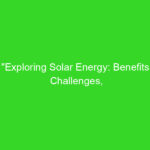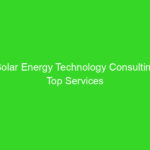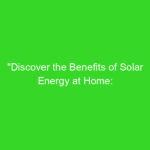
Passive vs Active Solar Energy
Solar energy is an excellent source of renewable energy that can be harnessed in two major ways - passive and active solar energy.
Passive solar energy refers to the use of the sun's energy for natural heating and cooling of buildings without the need for mechanical or electrical devices. On the other hand, active solar energy refers to the use of mechanical or electrical devices to convert sunlight into electricity or heat.
In this article, we will go over the differences between passive and active solar energy, as well as the pros and cons of each.
Passive Solar Energy
Passive solar energy utilizes the natural heat and light of the sun to provide heating and cooling to buildings. This method works through the orientation, design, and construction of a building. The idea is to maximize the amount of sunlight that enters the building and to minimize its loss.
Some examples of passive solar energy techniques include:
Solar Orientation
The orientation of the building is critical in passive solar design. The building should be placed in such a way that it receives maximum sunlight during the winter months and minimum sunlight during the summer months. This can be achieved by aligning the building in an east-west direction with the longest side facing south.
Insulation
Insulation is essential in passive solar design since it prevents heat loss during the winter months and heat gain during the summer months. The insulation should be placed in walls, floors, and roofs to maximize its effectiveness.
Thermal Mass
Thermal mass refers to the materials used to store and retain heat in the building. These materials can include concrete, bricks, and tiles. The thermal mass should be placed in areas that receive maximum sunlight to absorb and store heat during the day and release it at night.
Natural Ventilation
Natural ventilation is vital in passive solar design since it helps to cool the building during the summer months. This can be achieved by using operable windows or vents to allow hot air to escape and cool air to enter the building.
Active Solar Energy
Active solar energy is the use of mechanical or electrical devices to convert the sun's energy into electricity or heat. This method includes solar panels, solar water heaters, and solar air heaters.
Solar Panels
Solar panels are the most popular form of active solar energy. They convert sunlight into electricity that can be used to power homes and buildings. Solar panels are mounted on the roof or on the ground and can be connected to the grid or used as stand-alone systems.
Solar Water Heaters
Solar water heaters use the sun's energy to heat water that can be used for showers, washing dishes, and other household needs. They are typically placed on the roof and are connected to a storage tank that holds the heated water.
Solar Air Heaters
Solar air heaters use the sun's energy to heat air that can be used to warm buildings. They are typically mounted on the roof or the south-facing wall of a building.
Pros and Cons
Both passive and active solar energy have their advantages and disadvantages.
Pros of Passive Solar Energy
- Low cost: Passive solar energy does not require any mechanical or electrical devices, making it a low-cost way to heat and cool buildings.
- Energy-efficient: Passive solar design is energy-efficient since it relies on natural processes to heat and cool the building.
- Low maintenance: Passive solar energy systems require little to no maintenance.
Cons of Passive Solar Energy
- Limited effectiveness: Passive solar energy is highly dependent on the building's orientation, design, and construction. If these factors are not optimal, passive solar energy may not be effective.
- Limited application: Passive solar energy is most effective in areas with high levels of sunlight. In areas with low sunlight, passive solar energy may not be as effective.
Pros of Active Solar Energy
- High effectiveness: Active solar energy is highly effective since it uses mechanical or electrical devices to convert sunlight into usable energy.
- Versatility: Active solar energy can be used to power homes, buildings, and even vehicles.
- Reduced carbon footprint: Active solar energy is a renewable energy source that does not produce greenhouse gas emissions.
Cons of Active Solar Energy
- High cost: Active solar energy systems can be costly to install and maintain.
- Dependent on sunlight: Active solar energy is highly dependent on sunlight, making it less effective in cloudy or shaded areas.
- Maintenance: Active solar energy systems require regular maintenance to ensure optimal performance.
Conclusion
Passive and active solar energy are two effective ways to harness the sun's energy. Passive solar energy is a low-cost, energy-efficient, and low-maintenance way to heat and cool buildings. On the other hand, active solar energy is highly effective, versatile, and reduces carbon emissions. The choice between passive and active solar energy depends on factors such as location, building design, and budget.





